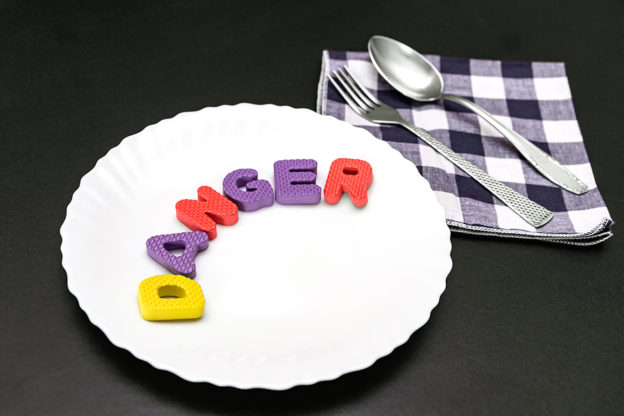By David Blyweiss, M.D., Advanced Natural Wellness
August 26, 2020
When food scientists work in their labs, they’re not making food that is good for you. Instead, they’re usually focused on money.
That’s because the right combination of fat, salt, sugar and acid will make your taste buds demand you keep eating and eating… buying and buying.
It’s something that has disgusted me for years. And it’s one of the main reasons why I push so hard for people to eat a healthy rainbow diet rather than highly processed foods.
Now, this advice is more important than ever.
That’s because the food industry is trying a new and disastrous scheme… now focused on the flavor from salt.
You see, people enjoy the flavor of salt, but we know that too much is unhealthy. So food companies are pushing scientists to replace sodium with something called monosodium glutamate or MSG. This is the same MSG that was discovered at the end of WWII when U.S. military personnel remarked that the Japanese MREs tasted better than their own because of this MSG in them…and a new industry was formed to add it to food; in canned vegetables, soups, processed meats etc. In fact you may remember it as Accent seasoning.
Sure, MSG use reduces the sodium content of certain foods. But it comes at a cost. Because MSG comes with a whole host of its own problems.
MD Exposes the Hidden Danger to Your Eyes

When your eyesight starts to fail, it's a real problem. Suddenly you can't go to the grocery store... you can't get to the doctor if you have an emergency... you can't meet your friends for dinner…
Your "regular" doctor doesn't have time to keep up with the latest research. And the same goes for eye doctors. They go to school to learn how to fit you for glasses and contacts, but have no way of preventing the damage and loss of eyesight that threatens your freedom and independence.
Let me show you something that explains a LOT about how your eyes work.
In my FREE Special Report, I'll show you a HUGE, untapped resource for your eyes that safely and naturally restores clear, effortless eyesight.
Click here to get started...
And let’s not forget to mention…
The main support for swapping sodium for MSG is coming from industry sponsored studies. In other words, the studies are paid for by the guys who make and sell MSG!
Lately, I’ve been seeing a lot more media support this scheme. Headlines such as “MSG isn’t as bad as it’s made out to be” and “Why MSG doesn’t deserve a bad rap” are showing up more and more frequently.
Is it true? Or are the companies selling this toxic substance just doing a lot of lobbying? Let’s take a look at some facts.
One of the first arguments you’ll see in these articles is that MSG is “Generally Recognized as Safe”, or GRAS. That’s misleading, since the FDA doesn’t determine GRAS status. The manufacturing company does. And they don’t even have to provide any notification or get any kind of approval from the FDA to make the statement.
In other words, GRAS is useless. And I can’t even tell you how many GRAS ingredients have been banned from use because of ill-health effects!
Another key argument is that glutamate occurs naturally in some foods. That’s true. You can find glutamate in foods such as tomatoes, cheese and mushrooms.
However, man-made MSG isn’t the same as that found in its natural form. It’s highly concentrated and almost entirely made of glutamates, which makes it much more potent than glutamate found in nature.
These same people will also argue that most of the studies on the horrible health effects of MSG have been performed on animals. Again, that’s true. But it doesn’t mean there isn’t plenty of scientific evidence of MSG’s effect on humans.
MSG is what we call a neuro-excitogen. At high concentrations, it stimulates over-excitation of nerve cells. This damages the cells and eventually leads to cell death through an extremely inflammatory process.
It’s also linked to fibromyalgia and chronic pain, irritable bowel syndrome, restless leg syndrome, obesity, migraine headaches and mental health issues.
And anyone who has experienced what people call “Chinese Restaurant Syndrome” knows the symptoms aren’t fake. The headaches, numbness, weakness, palpitations and flushing are all too real.
The World's Quickest Solution for Ending Prostate and Urinary Misery
This has recently been revealed to be one of the only real breakthroughs in prostate health.
The seeds of a strange fruit (sometimes called "Chinese Apples") hold powerful phytonutrients that are a revolution in prostate health.
In fact, UCLA and Veterans Administration research have now proved this to be true.
Not only that, but it may be the worlds quickest solution for ending prostate misery.
Simply stated, these phytonutrients represent a huge step beyond beta sitosterol, saw palmetto, and other phytosterols alone.
Simply click HERE if you want to have fast prostate relief...restful, uninterrupted sleep...no more constant "urges to go"...enhanced virility...and optimal prostate support for life.
So the idea of replacing sodium with MSG is just ludicrous.
Not only that, but the latest research suggesting replacing sodium with MSG was funded by Ajinomoto Co., a leader in the MSG industry. Their study showed that replacing sodium with MSG in certain foods could only decrease sodium intake by about 3%.
That’s just a drop in the bucket! You could drop your sodium intake by 3% – without ingesting more of a dangerous food additive. Simply cut 40 grams of sodium from your diet each day.
So instead of putting more dangerous substances in your body, try this…
How to Tame Your Salt Cravings
- Take the salt shaker off the table. Don’t salt your food until after you taste it. I tend to season my foods liberally with extra virgin olive oil mixed with garlic, herbs and a little lemon juice. I urge you to give it a try. You’ll be surprisingly pleased with this explosion of flavors.
- Avoid canned and packaged foods as much as possible. They are generally high in BOTH sodium and MSG. Opting for fresh organic produce and clean animal proteins is always your best bet.
However, if canned foods are your only option, look for ones that are “salt/sodium free” (meaning it contains less than 5 mg of sodium per serving) or “very low sodium” (which must have less than 35 mg of sodium in a serving).
And please! Bypass low sodium, reduced sodium and lightly salted foods. These are all misleading claims and can contain much more salt than you would imagine.
- Instead of reaching for the salt-shaker, reach for hot sauce, fresh chili peppers or red pepper flakes.
Why? Well it turns out that capsaicin, the main ingredient that makes chili peppers hot, enhances the salty flavor in foods. This means that when you add it to your foods you can use less salt and still get the flavor you want.
But you don’t need to go overboard with it. A little bit goes a long way.
- When you go out to eat, check the restaurant menu online before leaving the house. Most restaurant websites now include nutrition info, so you can plan your low-sodium meal in advance.
- As always, remember to check the sodium content on nutrition panels before purchasing any food item. It doesn’t matter if it’s soup, bread, cottage cheese, salad dressing or any other food that sounds harmless. Many foods that don’t taste the least bit salty can have a pretty hefty sodium content.
And when analyzing those nutrition panels, don’t forget to check the serving size against the amount of sodium per serving. Often times something that looks like a single serving could contain three or four servings. So you have to multiply sodium content by that amount if you plan to eat it all.
- On those occasions when you do want salt, use a darker sea salt or himalayan salt. Unlike processed iodized salt, they retain important trace minerals like magnesium, potassium and calcium that help offset the negative health effects of too much sodium.
Finally, limit your MSG intake as much as possible. This can be tricky, because it goes by many names. However, truthinlabling.org has created a very in-depth list that can help you discover secret MSG ingredients that might be hidden in your food.
SOURCES:
Maluly DB, et al. Monosodium glutamate as a tool to reduce sodium in foodstuffs: Technological and safety aspects. Food Sci Nutr. 2017 Nov; 5(6): 1039–1048.
Wallace TC, et al. Current Sodium Intakes in the United States and the Modelling of Glutamate’s Incorporation into Select Savory Products. Nutrients 2019, 11, 2691.
Holton KF, et al. The effect of dietary glutamate on fibromyalgia and irritable bowel symptoms. Clin Exp Rheumatol. 2012 Nov-Dec;30(6 Suppl 74):10-7.
Kraal AZ, et al. Could Dietary Glutamate Play a Role in Psychiatric Distress? Neuropsychobiology. 2019 Jan 30:1-7.
Allen RP, et al. Thalamic glutamate/glutamine in restless legs syndrome: increased and related to disturbed sleep. Neurology. 2013 May 28;80(22):2028-34.
He K, et al. Consumption of monosodium glutamate in relation to incidence of overweight in Chinese adults: China Health and Nutrition Survey (CHNS). Am J Clin Nutr. 2011 Jun;93(6):1328-36.
Chan K, et al. Glutamate receptor antagonists in the management of migraine. Drugs. 2014 Jul;74(11):1165-76.
Yeomans MR, et al. Acquired flavor acceptance and intake facilitated by monosodium glutamate in humans. Physiol Behav. 2008 Mar 18;93(4-5):958-66.
Yang WH, et al. The monosodium glutamate symptom complex: assessment in a double-blind, placebo-controlled, randomized study. J Allergy Clin Immunol. 1997 Jun;99(6 Pt 1):757-62.
Li Q, et al. Enjoyment of Spicy Flavor Enhances Central Salty-Taste Perception and Reduces Salt Intake and Blood Pressure. Hypertension. 2017 Dec;70(6):1291-1299.







